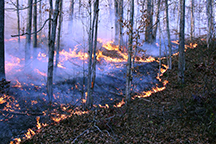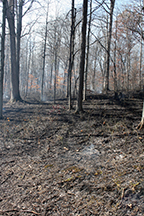Purdue researcher leading burn projects to regenerate oak forests
December 23, 2014
 |
|
Purdue forestry and natural resources graduate student Ethan Belair sets a fire line with a drip torch to start of a prescribed fire at Naval Support Installation Crane in Indiana. (Purdue Department of Forestry and Natural Resources photo/Michael Saunders) |
WEST LAFAYETTE, Ind. - A Purdue University researcher is leading two projects designed to foster the regeneration of oak forests and improve wildlife habitat by burning smaller trees and other inhibiting plants.
Michael Saunders, associate professor of forestry, is directing a little-used practice in Indiana called "prescribed burning" - small, controlled fires to kill young trees and shrubs that cover the ground with shade and prevent oak seedlings from growing.
"What we are doing is renewing the forest," Saunders said. "The burns will increase the resiliency of the forests, increase oak regeneration and provide better wildlife habitat."
Saunders led two prescribed burns in 80 acres of the 63,000-acre oak forest at Naval Support Installation Crane in southwest Indiana this fall in a project funded by a grant from the U.S. Department of Navy.
There also will be burns in the spring and fall of 2015 and in the spring of 2016 in the Yellowwood and Morgan Monroe State Forests in the Bloomington area under a grant from the Indiana Division of Forestry. Those burns will be conducted as part of the Hardwood Ecosystem Experiment, a long-term study of forest management in Indiana and its effects on plants and animals. All told, there will be burns in about 200 acres at more than 15 sites.
Oak is valued for its use in wood products. Saunders called oak "the driver of the timber industry in Indiana."
 |
|
A prescribed fire moves through the oak forest at Naval Support Installation Crane in Indiana. (Purdue Department of Forestry and Natural Resources photo/Michael Saunders) |
Researchers want to determine how the prescribed burns will affect oak regeneration; wildlife such as salamanders and birds; and insects such as butterflies, spiders and beetles.
Saunders expects that the fires will lead to growth of more wildflowers and grasses in the forests' understory - shrubs and small trees beneath the main canopy of larger trees such as oak. Shade from the understory and midstory - larger trees under the oak canopy such as maple and beech - inhibits growth of wildflowers and grasses, which wildlife and insects need.
 |
|
A prescribed fire has consumed much of the litter and small twigs in part of an oak forest at Naval Support Installation Crane in Indiana, leaving larger pieces of dead wood intact. (Purdue Department of Forestry and Natural Resources photo/Michael Saunders) |
Shade from the understory and midstory also prevent oak seedlings from growing into mature trees. Saunders said that as older oak trees die in forests with heavy shade, there are no younger oak trees to replace them. Instead, the midstory trees eventually overtake the oaks.
"If we don't kill the midstory trees, then they eventually will become the overstory, which will change the forest," Saunders said. Oak-dominated forests, which are exceedingly valuable to wildlife, could be replaced by maple-dominated forests throughout a large portion of the state.
Oak trees survive the burning because they are well adapted to fire. "They are much more able to respond after a fire than most other species," Saunders said.
Prescribed burns are common in the Ozarks - mountains in parts of Missouri, Arkansas, Oklahoma and Kansas - and in the Appalachians of Pennsylvania because of generally drier conditions than in Indiana.
Currently, prescribed burns in Indiana are limited to grasslands, such as prairies at Prophetstown State Park in Tippecanoe County. The best times for burns in Indiana typically are a few weeks in both the spring and fall. They can't be done in the dryness of summer because of the threat to residential property and the nuisance of smoke.
Prescribed burns are nothing new to oak forests. Saunders said Native Americans used them to promote berry growth and wildlife and to make travel lanes.
"There are thousands of years of history in this," Saunders said.
---
Little-known fact: Oak grown at the Navy's Crane installation is used in the periodic restoration of the USS Constitution frigate in the Boston Harbor. Launched in 1797 and nicknamed Old Ironsides, it is the oldest commissioned warship afloat.
Writer: Keith Robinson, 765-494-2722, robins89@purdue.edu
Source: Michael Saunders, 765-430-1440, msaunder@purdue.edu
Ag Communications: (765) 494-2722;
Keith Robinson, robins89@purdue.edu
Agriculture News Page

